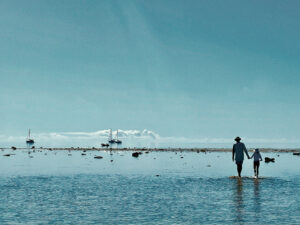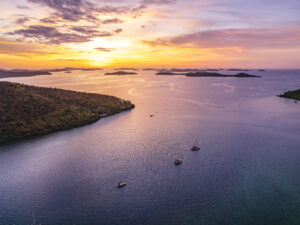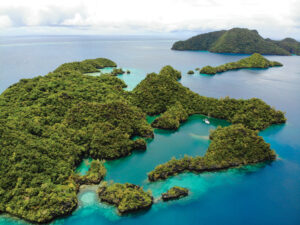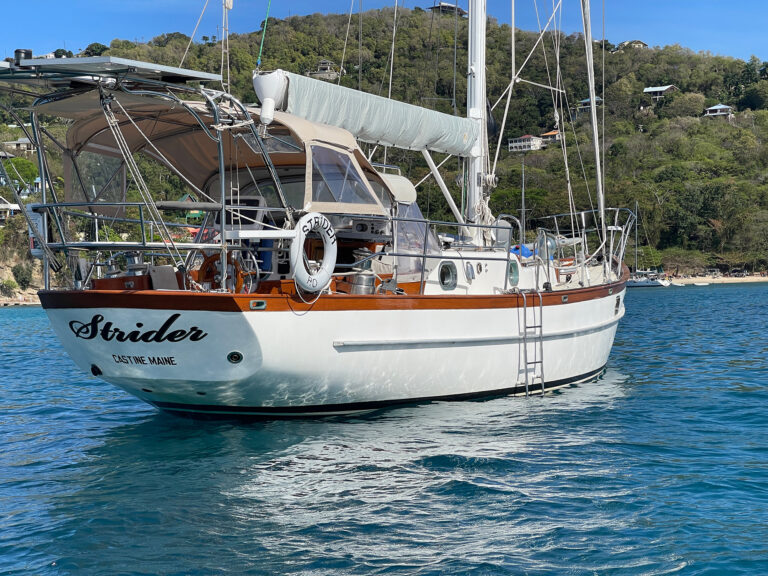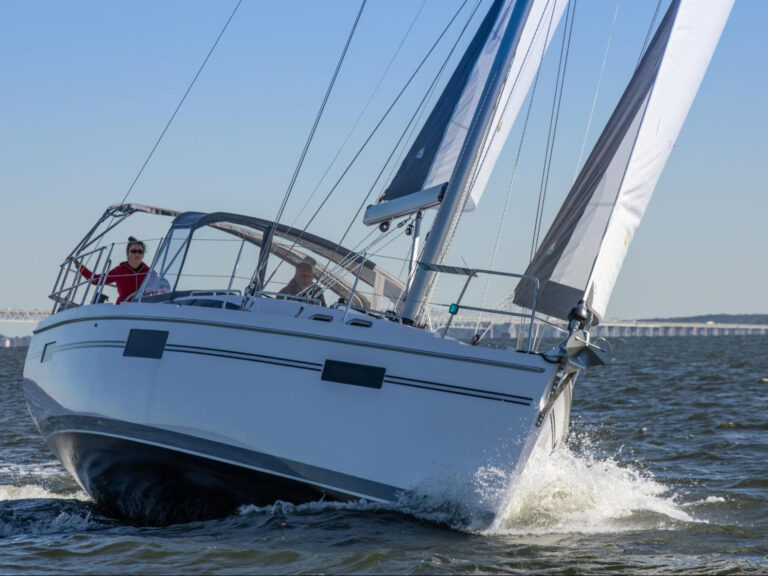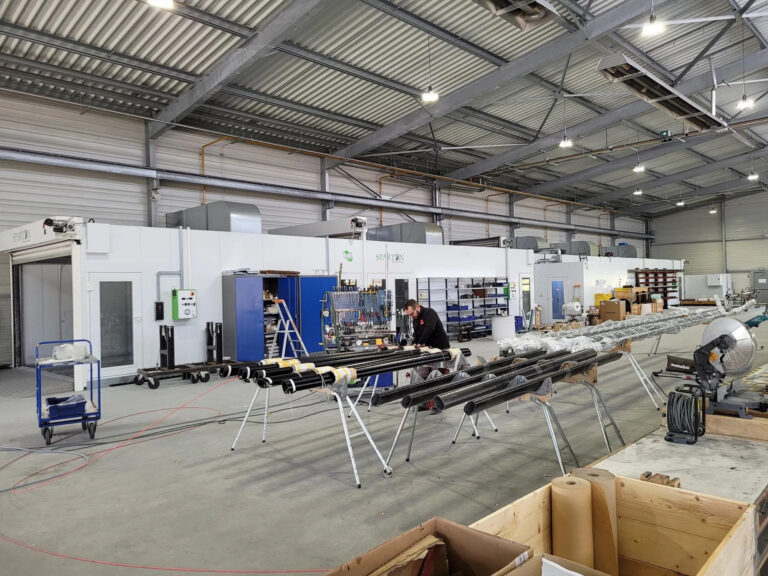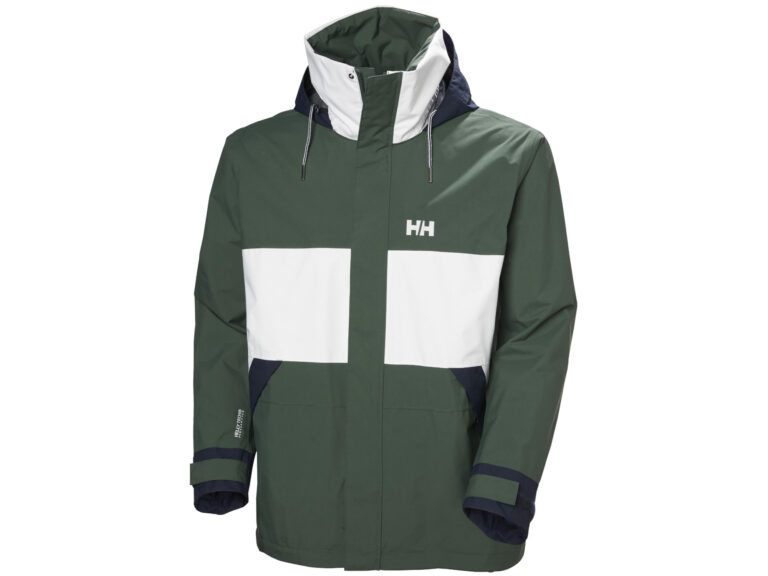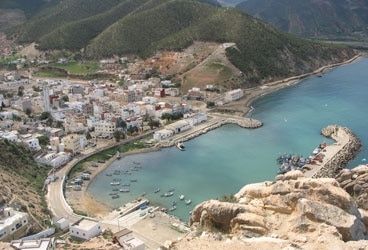
Morocco 368
Right when I needed them, the dolphins appeared. I was entering North African waters, and when three of them arrived to frolic in the bow wave, I found their playful curiosity reassuring.
It was April 2006, the conflict in Iraq was ongoing, and the United States was widely despised in the Muslim world. I was sailing Ranger, my U.S.-flagged 35-foot Allied Seabreeze yawl, into Morocco, a Muslim state since the 7th century.
Which is why, despite my trepidation, I was going.
After sailing from the United States to Portugal (see “Ranger’s Refit-and the Real Rewards,” June 2003), I’d planned to explore the Mediterranean. In yacht-speak, that means Europe: the Balearics, France, Italy, and Greece. My original goal, half serious, was to someday sail into Monaco and have a drink with the prince.
But as I sailed from Portugal through the Strait of Gibraltar, Africa loomed on the southern horizon, the proverbial elephant in the room. At the strait’s narrowest point, the “dark continent,” here just eight miles from Europe, appeared an inviting blue. Its allure grew as I studied a chart of the Med, the whole Med, and began reading about the history of this ancient sea.
Daily headlines from a post-9/11 world only exposed the depth of my ignorance of this region. Phoenicians, Romans, Christians, and Moors had ridden its currents and winds, leaving in their wakes diverse cultures. The current upheavals in Iraq and among its neighbors were but the latest manifestations of the divisions that have flourished in the area.
The northern half of my chart was a well-known entity: wealthy, developed, and expensive for yachtsmen. Spain’s Costa del Sol, where Ranger had spent two years on the hard, was chockablock with condos and centers of tourism in which Spanish was the second language. Where condos hadn’t sprung up, Europe’s vegetables grew under miles of unsightly plastic greenhouses.
I still hoped for a beer with the prince, but 100 miles to my south lay a coast whose foreignness to me begged understanding. As I weighed the risks, I reminded myself why I leave safe harbors: I do it to learn something new. This time, my subject would be Morocco.
I left my base of Almerimar, Spain, and because of currents, which set east from Gibraltar, and because I was singlehanding, I sailed west toward the Rock.
“Sailed” is a hopeful term in the Alboran Sea, where calms erupt into 30-knot blasts that suddenly die. For a couple of days, Laurel and Hardy changed my sails as I cursed the wind, sold my boat, or opened champagne and drank a toast to my good fortune, sometimes all in the space of an hour.
After two blissful nights at anchor, spent lying on my back and studying the stars, I took a slip at Sotogrande, Spain, the largest resort and privately owned residential development in Andalusia. Located north of Gibraltar and catering to a British clientele, the development seemed full of car salesmen and their remarkably chested companions. Taking the slip proved fortuitous, however, because next to me was Graham Hutt, author of North Africa, the cruising guide published by the Royal Cruising Club Pilotage Foundation. I’d practically memorized Hutt’s book, a mix of history and warnings laced with an enthusiasm for exploring the African Mediterranean. He assured me of a warm welcome in Morocco and handed me another book he’d written. I turned in, a little nervous about crossing.
I needn’t have been. In bright rising sun and flat calm, the Pillars of Hercules rose from a deep-blue sea, framing the strait. It’s a dramatic sight that evokes images of a time when the known world ended here-Nec Plus Ultra, or Nothing Beyond. I motored past Europa Point, crossed the wake of Columbus, who changed all that (Spain’s motto became Plus Ultra, or Farther Beyond), and threaded a convoy of tankers that followed his path.
As Gibraltar and the West slid away in a blue haze, North Africa loomed as a dun, mountainous outline. I don’t know where I’d got the impression that the Sahara came down to the sea, but as I approached closer, Morocco turned green.
The dolphins arrived below Monte Hacho, the southern Pillar of Hercules, which marks both the Africa continent and the Spanish presidio of Ceuta, a remnant of colonial times. A huge catamaran ferry from Algeciras, Spain, slid into port. It runs every hour, takes 40 minutes, and costs 18 euros, about US$30.
Marina Smir, just south of Ceuta, is run by a Spanish corporation. I pulled up to the control tower and was greeted in hearty English by a friendly marinero. Efficient clerks in a bright, modern office signed me in, swiped my credit card, and directed me around a corner to a cluster of uniformed men playing cards, their TV tuned to a soccer match.
One of them took my passport and disappeared. Hutt had written that in the 1990s, police and customs officers harassed yachtsmen, made “extensive and indiscriminate searches,” and demanded baksheesh, or bribes, of whiskey and cigarettes. The reputation lingered, perhaps, because the marina was virtually empty. Only two other yachts were there, and they were leaving because of the high fees, about 16 euros a day, three times Almerimar’s off-season rate.
So imagine my surprise when, 15 minutes later, my passport came back, stamped in Arabic, French, and English. I was led to a convenient quay, welcomed to Morocco, and left alone. It was the first of many surprises.
“Is it safe?” I shouted to the marinero.
“Very safe,” he said, giving a wave.
The second surprise was beer and pizza, in the only restaurant open. Marina Smir is a clean, upscale establishment with a palm-lined court of empty storefronts. Moroccans strolled by in slacks and skirts, half the women in scarves and robes. They snapped photos of each other in front of an ostentatious motor-yacht. Next to me, two young men sat with their pizza, beer, a cellphone, a pack of Marlboros, and a digital camera.
That night, I opened Hutt’s new book, A Minor Indiscretion. On its cover, ominously, was the image of a barren jail cell, with a glimpse of a sailboat visible far off through its small window.
In 1998, while in this marina during a research trip for his cruising guide, Hutt and his crew were jailed after police found one of the members with a backpack of Bibles, apparently brought to give away. When the crew signed a confession they couldn’t read that had them planning an overthrow of the Muslim nation, Hutt faced a jail term, a fine equivalent to US$500,000, and the loss of his yacht.
It’s a harrowing tale of events apparently set in motion by a corrupt official who wanted Hutt’s boat and complicated by a legal system with different rules of evidence. If Hutt hadn’t concealed a cellphone with which to call his wife and hadn’t known the King’s chief of staff, he might still be rotting in a dank cell, in the company of bleeding political prisoners whose cries he described in detail.
Needless to say, it gave me the willies. I began to see secret police in every casual passerby. Hutt, a British citizen who holds a doctorate, speaks Arabic, and has adopted a Moroccan girl but who now admits a “deep mistrust of the Moroccan government,” said later that my suspicions were warranted.
“The police and military,” he e-mailed to me, “know everything that’s going on and go out of their way to protect foreigners and their interest.”
So security was double-edged, just as it had become at home in the United States. Paranoid, I retrieved and burned postcards that I’d handed to a storeowner to mail to friends in the United States because of a quip I’d included about Easter with Allah.
I caught a ride to Tétouan, an ancient city 30 miles away and a wild mix of whitewashed walls from the 15th century sprouting satellite dishes.
Stepping into a darkened den, I found myself amid scores of men in robes and sandals who were talking, sipping strong coffee, snoozing, smoking hookahs, and playing games with a loud clacking of pieces. A few dozen of them had lined up their chairs theater-style facing a corner and sat mesmerized before a television playing Lara Craft: Tomb Raider, starring Angelina Jolie. She was, at that moment, exploding a ghoul with a gun the size of a watermelon.
Every face in the place represented a civilization. I was dying to take photographs, but whenever I raised my camera, Moroccans, especially women, turned away. Later, when I hired a guide, he negotiated several shots for me.
Tétouan’s old section, its medina, a UNESCO World Heritage Site, is a warren of alleys and arches, elaborate doors, and market stalls dating to the 8th century. I could’ve spent days exploring the souk, or market, which overflows with spices, vegetables, chickens both dead and alive, tin pots, women’s shoes, and fresh kesra, Morocco’s ubiquitous round loaves of bread. Its culture and architecture is Andalusian, forged by Jews and Muslims driven from Spain by Ferdinand and Isabella, and Tétouan has been called “Little Jerusalem” and “Daughter of Granada.” According to the U.S. State Department, Morocco’s population of 31.4 million is 99.9 percent Muslim, with 4,000 Jews and 1,000 Christians.
Inevitably, I was led to a rug dealer, who gave me hot mint tea and unrolled 35 beautiful rugs, made, he said, by mountain women. He was a virtuoso, and almost based solely on his performance, I bought one and had it shipped home. At the last moment, he recommended “insurance” of 400 dirhams (US$45), which disappeared into his robe.
I was glad to get back on the water and head southeast along a coast as handsome as I’ve ever seen. It’s a mix of mountains, seaside cliffs, beaches, steep meadows, and the occasional village tucked into a cleft through which impressive peaks, some capped with snow, can be seen in the distance.
And I had it to myself. One likely reason is that visiting yachts aren’t welcome to explore and drop anchor just anywhere. Before I left, the police took down my itinerary. Ostensibly, they’re trying to stop drug traffic to Europe. They seize 500 tons of hashish a year, according to Marvine Howe’s book, Morocco: The Islamist Awakening and Other Challenges. It must be a drop in the bucket, though. Morocco is the world leader in marijuana production; it’s grown on 335,000 acres, a quarter of the farmland in the Er Rif, the crescent of mountains along the coast. Enormous swaths of kif fields were visible from Ranger.
Pot is a symptom of a national equivocation that allows cultivation and open use, embraces the infusion of cash into a subsistence economy, and accepts an arms-length control of what Howe calls “the indomitable Rif.” Protected by their terrain, Berber tribesmen have, in turn, fought off the French, the Spanish, and Moroccan central authority.
When not gawking, I kept busy reefing and shaking out sails, trimming, and watching for blasts of sirocco-like winds that gushed down the gaps in the mountains. Gibraltar Radio and my new Navtex English-text forecasts both assured me of light westerlies in the Alboran. At times they were right, but I ended up motorsailing into a brisk easterly as I nosed into the fishing harbor of El Jabha.
The first thing I noticed was a soldier standing on the hillside beside one of the characteristic little peaked guard shacks and watching me through binoculars. The second was a clutch of wooden sardine trawlers rafted along a concrete quay, their battered sides protected by old tires. There was no place for a sailboat.
A couple of young men motioned me to come alongside their trawler, which was rafted third out. Within a few minutes a gendarme and several villagers had crawled across to begin “formalities.”
It took five languages (French, Spanish, Arabic, Berber, and English), a lot of hand waving, and the reading of a rarely used form-all in good humor-to complete my clearance. At some point, a young uniformed man, realizing he had nothing more to suspect, stuck out his hand and said, “Welcome.”
Later, the haunting cry of the call to prayer came from a minaret high above the central mosque. A few people, and some of the fishermen, rolled out prayer mats where they were and bowed to the east, but most went about their business.
Morocco, on the western frontier of Islam-the Maghreb region-was born a bridge between East and West and has managed a political stance that includes both western culture and Islamist fundamentalism. Moroccan citizens have been terrorists, in Casablanca, Madrid, and Iraq-one Tétouan neighborhood, in fact, produced 13 jihadists-but Morocco was also the only Arab country to publicly mourn America’s loss on September 11, 2001. More recently, Morocco and the United States signed a free-trade pact.
According to Howe, Morocco’s king, who has absolute power, has kept radical Islam in check by basically throwing suspects in prison while executing others. Internal pressure to democratize, ironically, has allowed Islamists the freedom to prevent women from gaining true equality.
In El Jabha, I was treated as an honored guest-and a curiosity. Nagib Ahannach, master of the rafted trawler, greeted me with his hand over his heart and a trilingual soliloquy that included the words “Live, die, guerre,” meaning, I think, that we all live and die and that war is bad for everyone.
In a harbor café where sardines simmered with onions, potatoes, and cumin in the national dish called tajine, village boys crowded around, whispering, “A-mad-i-can.” Who, I wondered, was discovering whom? As I roamed the streets and looked into shops, several villagers mentioned Iraq, dismissed it with a wince and a wave, but never showed the least animosity toward me. At the central mosque, when I stuck my head in a classroom, children lined up to kiss my hand.
To fishermen, I was a fellow mariner who’d paid a rare visit. Morning and night, they tied and untied and prodded their trawlers into the harbor while passing Ranger quay-ward, smiling and shouting to me, “Tranquilo!” The whole town greeted the fleet’s return, children wiggling to the front, each clutching a plastic bag to fill with sardines for supper.
When I brought out my digital camera and showed them the instant picture display, boys began to line up for shots. They were handsome children, and I found it hard to imagine them growing up with anti-American sentiment. Even crusty fishermen smiled shyly, then hooted at expressions caught on film.
In the bonhomie, a couple of young men dropped hints about Spain-one asked for the compass bearing to El Ejido, the vegetable capital next to Almerimar.
I was touched by El Jabha’s hospitality and painted a quick sketch of Ranger on the quay. Early one morning, as the warble of prayer came from the minaret, I slipped away and headed east.
It was uphill against a current of two knots, so it took a long day to motor 43 miles to Al Hoceima, a large port with a bad reputation. “This is one of the only ports in Morocco where yachts have never been welcome,” Hutt warned. “It isn’t uncommon for up to 10 officials to come aboard, all with their heavy boots on.”
To my relief, one pleasant policeman walked up, took my papers, and said I was free to explore the city. Later, a coast-guard official filled out papers, too, but no one came aboard, and by nightfall I had my passport. But it was clear that Big Brother had kept track of me. They asked for the names of my mother and father.
On my way to town, I was greeted by a friendly, English-speaking young man who invited me to coffee. A college grad, he was dying to talk issues. But there was something else, and it came out when I resisted meeting again.
“Are you afraid I’m going to ask you to take me to Spain?” he asked. Then he admitted that he’d been stopped before. After crossing to Málaga in a raft with an outboard, he was caught trying to board a train to Barcelona.
A few Moroccans and many more sub-Saharan nationals die trying to float north to an economy that’s 15 times stronger than Morocco’s. Many others make it, and they’re unofficially welcomed with jobs. Officially, the European Union funds better security, including fences around Spain’s enclaves on the Moroccan coast, Ceuta and Melilla. Not long before I sailed, 15 people were shot to death trying to scale those fences.
I quickly distanced myself from my new best friend, but I did warm to three powerboaters who were remodeling a large motoryacht that had been confiscated in a drug arrest. We were tied up together on a new concrete dock optimistically called the “Ferry Terminal.”
I walked up the steep steps to check the weather at a cybercafé, which had a French keyboard. With my deadline to fly home bearing down, I was tempted to leave Ranger in Morocco. Weighing my choices, I reviewed in microcosm the yachting situation on the African Med.
Al Hoceima would’ve been cheap, maybe 1,000 euros a year. But only two yachts were in the fishing harbor, and one of them looked abandoned: The sails were tattered, and grimy children climbed in and out of the open holds. Even if I hired a “guard,” I might return in six to 12 months to find a hulk.
An e-mail from Hutt, whose advice I’d solicited, suggested that anti-Westerner sentiment was unlikely to encroach into the ports. He wrote, “My feeling is that your yacht would be safe. However, a changing political situation may unnerve you when away from the boat.”
It costs more to board a boat at Marina Smir than at Almerimar, marinas at Spanish Ceuta and Melilla had histories of vandalism, and a new French marina at Saïdia, near the border with Algeria, hadn’t yet opened.
Algeria is fighting a civil war. Hutt reported that the military assigned him a machine gun-toting escort whenever he left the boat. Libya, he understated, may be years from extending a warm welcome but “is no longer unsafe for the adventurous to visit.”
That left Tunisia, 900 miles away, which, from all reports, is cheap and safe thanks to a virtual dictatorship that enforces a moderate Muslim culture.
A more practical issue prevailed in my case. I was out of time, and Al Hoceima didn’t have a lift large enough for Ranger’s nine tons. I bought an alarm clock to keep me awake for 24 hours, caught the next weather window, and motorsailed across the sea that divides us, East and West.
In a yacht, it’s easy to skim the surface of a country’s coast, like a water bug that never breaks tension. I’m embarrassed by how much I didn’t know at the time of my visit: about Morocco’s censorship of writers, its second-class citizenship for women, and, above all, how complicated the struggle is for the soul of Islam. The Alboran Sea divides a world in which Europe worships the euro and lets go of its god, while a growing number of Muslims cling ever harder to theirs.
But I also believe that from my little ship, the rhythm of a human heart beating sends out ripples that former strangers on their distant shore can sense.
After exploring Morocco, then covering the America’s Cup in Valencia, Spain (see “Ranger’s View of Sailing’s Oldest Trophy,” September 2007), Jim Carrier plans to keep exploring the Med’s many dimensions.

